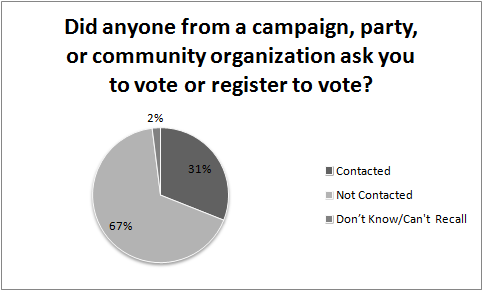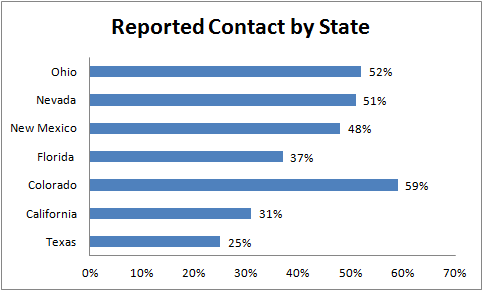The 2012 election was a watershed moment for the Latino electorate in many respects. In giving President Obama a record level of support (75%), Latinos were decisive to the outcome; an unprecedented mark of influence for this segment of the electorate. Prior to Election Day, both parties went out of their way to include more Latinos in marquee roles their conventions. And after the election Latinos have remained at the center of national discussions about a potentially enduring coalition of minority voters, and the future of the Republican party. 2012 was undoubtedly big for Latinos.
Despite all of these high-water marks, we have yet to see Latinos actualize their full voting potential. To be fair, no group turns out at 100% of their voters, but the larger point is, Latinos remain underrepresented at the ballot box. This post considers the scope of the potential Latino electorate and the role that party and campaign mobilization efforts have in shaping Latino registration and turnout rates.
The National Association of Latino Elected Officials (NALEO) estimates that 12.2 million Latinos voted this past election, representing approximately 10% of the national electorate. That number is much too low when we consider that an estimated 2.5 million Latinos who were registered to vote did not cast a ballot in the presidential election. And, an additional 8.6 million Latinos are eligible to register to vote (18 years old or older, and American citizens) but are not registered. There are almost as many potential Latino voters (registered and not voting, or eligible but not registered to vote) 11.1 million, as there are actual Latino voters (12.2 million).
The impact that a more engaged Latino electorate could have becomes more apparent when we look at individual states. There are an estimated 2.1 million Latino eligible voters who are not registered to vote in Texas, and another 2 million in California. There are another million eligible but not yet registered Latinos in Arizona (405,000) and Florida (638,000) combined, two highly contested states where an increase in Latino turnout could have huge ramifications to both federal and state level races. Without even considering the millions of Latinos who are currently eligible for citizenship (legal permanent residents, or LPRs) and the millions more who could be voters if comprehensive immigration reform were to be passed, these two groups of potential voters add up to over 11 million Latinos who are eligible to vote today!
It is fair to think of the potential Latino electorate as an untapped source because the vast majority of the Latino electorate is not targeted for voter mobilization. Our Election Eve Poll indicates that only 31% of Latino voters were contacted by a campaign, political party, or community organization to either register to vote or cast a ballot during the 2012 campaign (Figure 1 below). This is a telling result. Even in this election, where Latinos were projected to be a key swing electorate, seven of every ten Latino voters were basically ignored during the election cycle. It is likely that the contact rate for the larger Latino population is even lower than the 31% observed among actual voters who are in our survey.

Source: impreMedia/Latino Decisions Election Eve Poll, November 2012
This is a telling result. Even in this election, where Latinos were projected to be a key swing electorate, seven of every ten Latino voters were basically ignored during the election cycle. It is likely that the contact rate for the larger Latino population is even lower than the 31% observed among actual voters who are in our survey.
Differential mobilization can have major implications on national Latino voter turnout rates. If voters are targeted only in competitive states, then Latinos will consistently be among the least encouraged to participate. More than 50% of the Latino electorate resides in non-competitive states like Texas, California, New York, and Illinois. The dismal contact rates in California (31%) and Texas (25%) point to this dilemma. It is important to note, however, that even Florida Latino voters, who were identified early as a critical voting group in the state had a relatively low contact rate too (37%). Furthermore, Spanish dominant Latino voters were even less likely to be contacted (23%) than those who conducted the survey in English (37%). Media buzz about campaign outreach efforts by both Romney and Obama might lead one to believe that all Latinos were mobilized equally, but such is not the case.
 Figure 2. 2012 Latino Voter Mobilization by State
Figure 2. 2012 Latino Voter Mobilization by State
Source: impreMedia/Latino Decisions Election Eve Poll, November 2012
Political science research consistently finds mobilization — and for Latinos, co-ethnic mobilization — increases participation rates. There is vast opportunity for parties, candidates, and other engagement-focused organizations to engage the Latino electorate; we are quite from reaching any upper limit in terms of voter contact. As policymakers, candidates, parties and their strategists look to future of electoral politics, they would be wise to look at the growing pool of eligible and soon to be eligible voters and invest now in voter registration and engagement efforts. Increased mobilization efforts could have a huge impact on Latino turnout, ensuring their investment would pay off for decades.
Gabriel R. Sanchez is an Associate Professor of Political Science at the University of New Mexico and Research Director for Latino Decisions.


